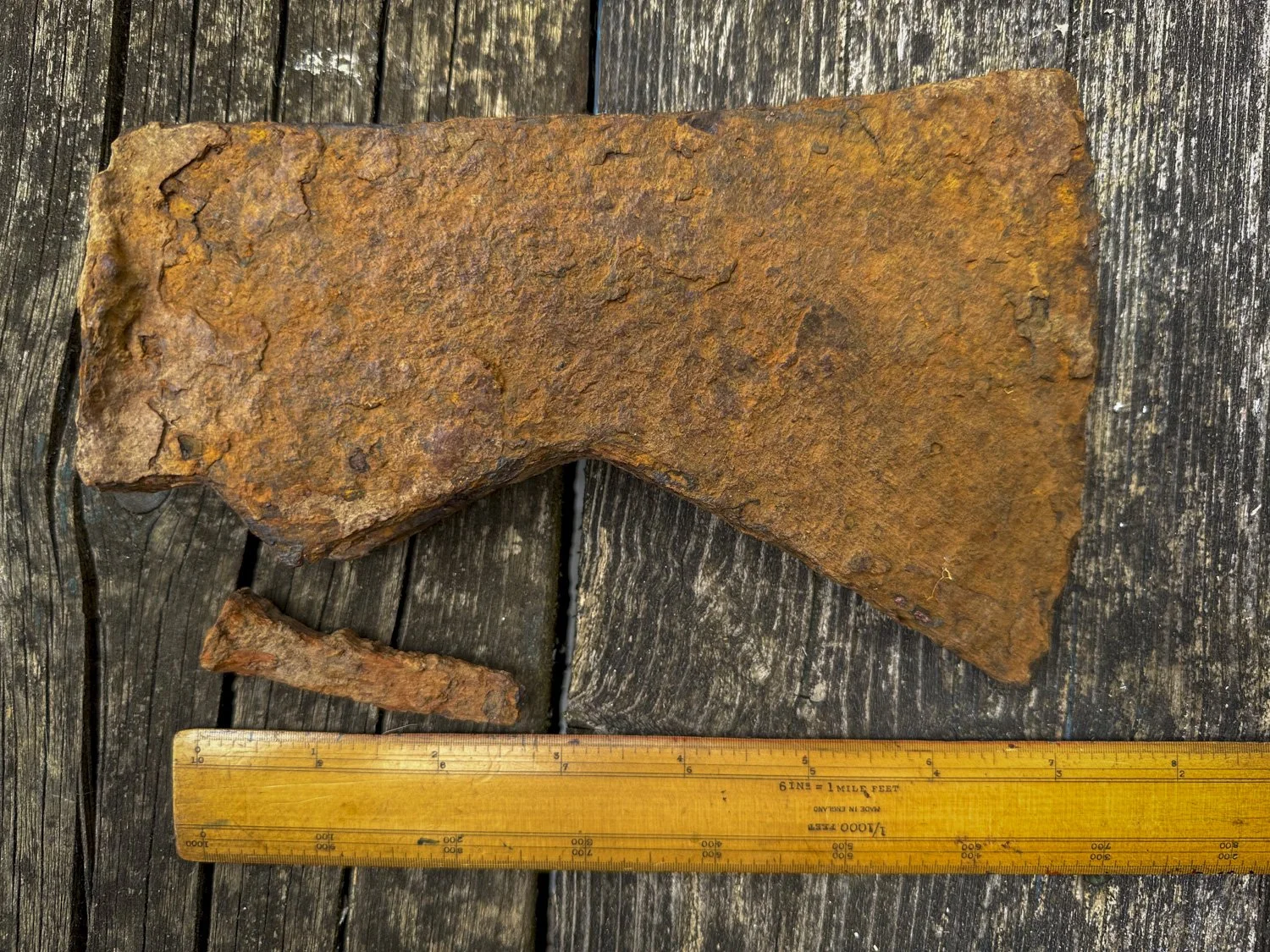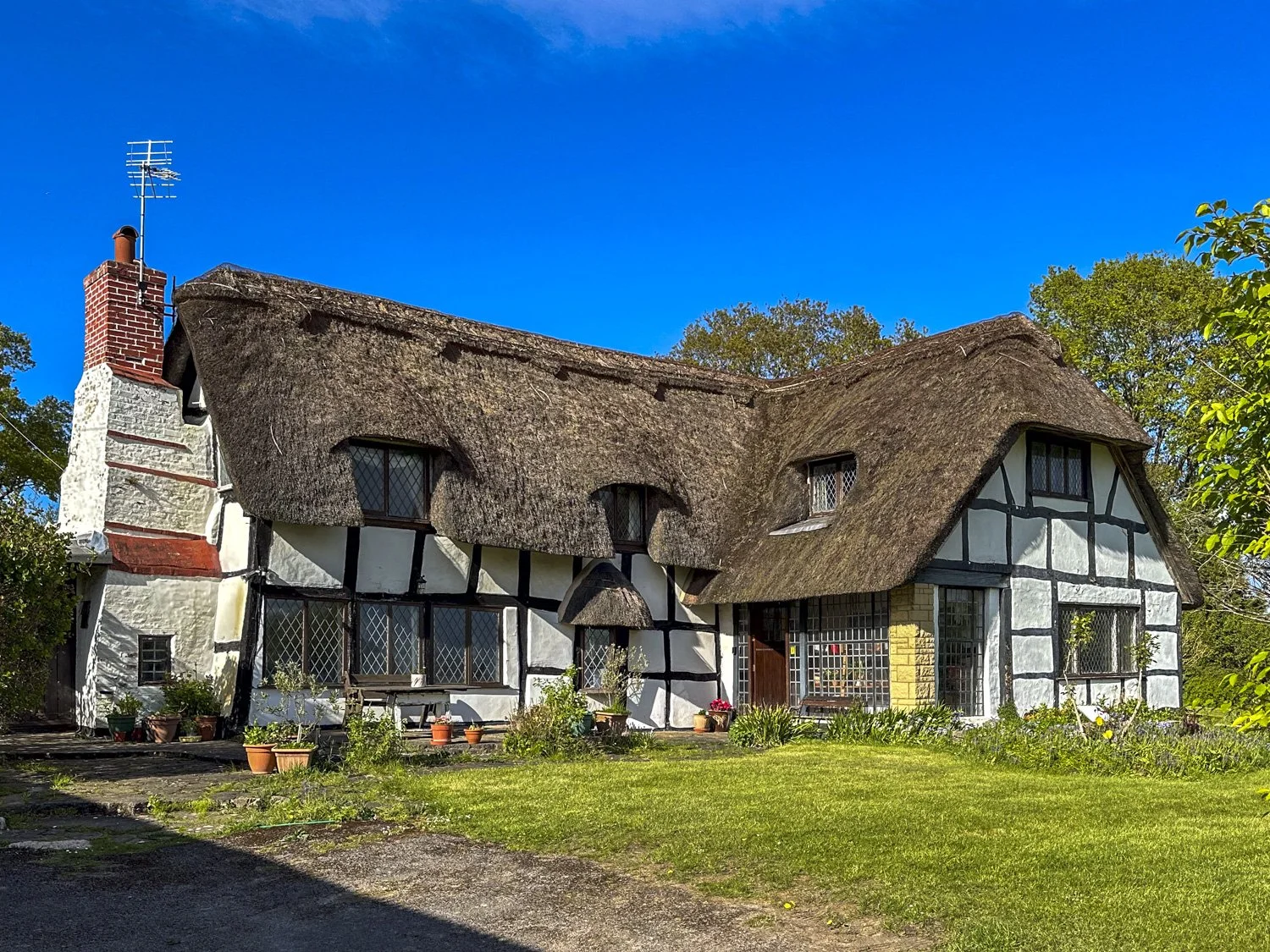Police Helmet Plate
Last year, while metal detecting in a field in Gloucestershire, I found this helmet plate, from the helmet of a policeman in the Gloucestershire Constabulary. The “G” stands for Gloucestershire, and the crown at the top shows that it’s from the reign of Victoria. I found, while researching this, that the constabulary used two versions of this during Victoria’s reign, and that this is the earlier of the two.
Something Shiny
Modern silver ring
A few weeks ago a friend asked me to look for two special therapeutic shoes that her horse had thrown. Sadly, I was unable to find either of the shoes (you’d think it would be easy!) but I was very happy to find this silver ring. It's not very old, but I haven't found many rings since I started metal detecting, and it’s always nice to see something shiny come out of the ground!
Not everything glitters
Sometimes the iron relics I find can be just as interesting as those made of silver and bronze. A recent example is the axehead pictured above, which I unearthed while detecting around the house pictured beneath it. The house was built in the early 17th century, and my research tells me the axehead is likely from the same period. It must’ve been dropped with the handle intact, because the wedge shown was still in place.
Digging with Audrey
Last month, I was lucky enough to enjoy two metal detecting outings with my daughter, and she found some interesting relics. Click on the photos above to see enlarged images.
First we have a child’s toy cannon from a time when it was considered safe and normal to give a young child a model cannon, some black powder, and a match. You can still see the touch hole where you would set the match to fire the cannon!
Next we have a small bell, which perhaps hung around the neck of a sheep. If you look closely you can see the hole where a bar (now missing) was inserted to hold the clapper.
Finally, we have an old poker. As we were digging, it became evident that there had been quite a lot of camping on the field. Among ashes and charcoal, Audrey found what seems to have been the handle of a little shovel, but was being used as a poker when it was lost while tending a fire some decades ago.
As I’ve said before, I find so much to enjoy in metal detecting—whether it’s thinking about the people who used these objects, or getting the chance to share my hobby with others, in this case my daughter.
A little Roman Fibula Brooch
In August of 2022 I went on a dig with a group called “Mid Week Searchers.” If you click on their name, you can see that they recently started an Instagram page showing some of the objects members have found on their digs. In August of 2022, I was lucky enough to find a little Roman brooch (click on the images above to see larger versions). I sent photos of it and other information to the Portable Antiquities Scheme. The Finds Liaison Officer who recorded it described the brooch like this:
A Roman copper alloy Colchester derivative, double pierced lug, Harlow type brooch dating to 43-70 AD. This has a double pieced lug on the rear of the head that holds the spring and external cord (the spring is made from 8 curls and the pin is complete). The wings have an undecorated convex face, but the front of the bow is decorated with a central ridge that runs its length and forms a crest at the top of the bow. The catch plate on the reverse is complete.
Wiltshire
It’s a funny feeling to suddenly see something like this turn up in a clod of soil. It’s such a personal item. One day, probably in the 1st century, someone used it to fasten their cloak, or hold back a fold in their tunic, and set about their day. As they walked along the field in the photo above, perhaps it caught on a hedge or just became unfastened, and was torn from their clothing. You can still see how the pin bent as it caught. It fell to the ground, and there it lay there, being tossed about by the plow until 2022.
In addition to being moved by the personal aspect of the brooch, I’m fascinated that it’s still complete and you can see the mechanism that gave the brooch its spring. It’s a single piece of metal that makes the point, curls around a pin, goes through a hole on the back and then wraps around the pin on the other side. You can also still see a faint reminder of the cross-hatch pattern that ran down its back.
As moving as it is to imagine the person who wore this brooch for the last time, it’s also something to think about the craftsperson who made it. Was it crafted in Britain, or brought here by the Romans who invaded and conquered the island less than 30 years earlier? Amazingly, the pin still flexes, though I don’t dare try to move it all the way down to the catch.
Whistles
I’ve found a few whistles over the past year or so. The first one was a standard issue tubular whistle, then two dog whistles (within a few days of each other), and just last Sunday, a conical whistle from the 19th century.
The Standard Issue, or police whistle, was invented after a request by the Metropolitan Police in 1883 for a whistle to replace the rattles Victorian police and their predecessors had used (believe it or not) to call for help or attract attention. The police wanted something less resistant to breaking that could be heard farther away (this whistle’s sound can travel up to a mile in good conditions), which wouldn’t be used to attack the police as the rattles sometimes were.
The dog whistle was invented in 1875 by Francis Doulton — the same man who invented the term “eugenics” and was a proponent of social Darwinism. Speaking of Darwin, Doulton was a cousin of Charles Darwin. The things one learns while researching metal-detecting finds!
The most recent whistle I found is a conical whistle. sometimes called a “Beaufort Whistle,” but that term seems to be a recent development. They were used as warning whistles for women and by some police forces before the invention of the Standard Issue tubular whistle (that is, if the weren’t hanging onto their trusty rattles).
The Beauty of Buckles
18th Century shoe buckle, 14-15th century buckle, some spectacle buckles, and more
There’s so much to like about buckles—from the human connection (who was wearing this the day it fell off or got discarded?), to the history. The shoe buckle in the top left is probably 18th century, while the second buckle in that row is from 1350-1450. The one at the end of the second row is from 1550-1650, and the one below it is a bit older, from 1350-1500*. Even the accretion of rust on some of the iron buckles catches my eye, and I love the beauty of the broken fragments. You can zoom in on the photo to see the details.
Thank you to members of the “Buckles through the ages” Facebook group for information on the types and ages of some of these.
Hammered Coins
Since my return to the UK nearly four years ago, I’ve been lucky enough to find a few hammered coins. These are coins that were made from the period after the Romans left Britain in around 410 AD up until the late 1600s. A piece of metal (usually silver or gold, sometimes other base metals) would be put between two dies and then the top die would be struck with a hammer. You can read more about hammered coins here.
I have found five of these coins so far and four of them are pictured above. I’ve arranged them so that the obverse (or heads) comes first, followed by the reverse (or tails) side. I’ll describe them from left to right, top row then bottom.
The first one is the oldest coin I’ve found. Thanks to some very knowledgeable people in Facebook’s “Hammered Coinage Identification Group,” I learned that this coin was made during the reign of King Henry II, between 1158 and 1163, by Rogier in Exeter. It got me wondering how a coin struck in Exeter made its way to a field in the Cotswolds, where it had lain until I happened upon it some 800 years later. The coin is known as a Tealby Penny due to the large hoard of them that was found in the village of Tealby in the early 19th century. You can find further information about these coins here.
The next coin is not quite as old, but is in much worse shape. It’s a very worn penny, made sometime between 1327 and 1509.
Following that is a Queen Mary groat (a four pence coin) struck between 1553 and 1554.
Finally, we have a sixpence of Queen Elizabeth I, struck in London in 1590 or shortly thereafter.
I hope you’ve enjoyed seeing these. It is such a pleasure to find, photograph, and learn about them… and share them with you.
A toy soldier
In the summer of 2020, I spent some more time at my friend’s house on the Eastern Shore of Maryland. It was the middle of Covid and I had a lot of time on my hands – and a metal detector!
One of the more interesting objects I found was this little painted soldier. He looks as if he’s from the Second World War. I wonder about the kids who were playing with him the day he got lost. Did they have to leave suddenly, and forget to grab him? Or was he dropped as someone walked by?
In preparing the photos for this post, I had some fun with the third photo using Adobe Photoshop’s new AI generative tools (a little plug for my real job - let me know if you’d like to know more). I think he’s on an island in the South Pacific…
One of my first finds
Soon after getting my first metal detector in late 2019, I drove to Maryland with my daughter. (We were living in Maine at the time.) I had been invited by my friend Bob to visit his place on the Eastern Shore. I had a lot to learn about using the detector, but shortly after we started, I got a promising signal on the front lawn. We dug and dug, and about 12 inches down, saw what looked like the green of old bronze.
Something that has never grown old over the four years that I’ve been detecting is that feeling of discovery when a new find is revealed. “What’s it going to be this time?” This first time was no different. Initially, we couldn’t figure out what the emerging object was. It certainly seemed large – much larger than a coin. The top of a lantern? As more of it was unearthed, it suddenly became clear – it really was a big crotal bell. Once we got it out and measured it, we found it was a number 15, and was over 3 inches in diameter. Certainly an exciting way to start of my metal detecting hobby!
I’ve been asked several times since I posted this, “What is a crotal bell?” In short, they are bells of various sizes that are hung on animals. Here’s a good article explaining more.






























